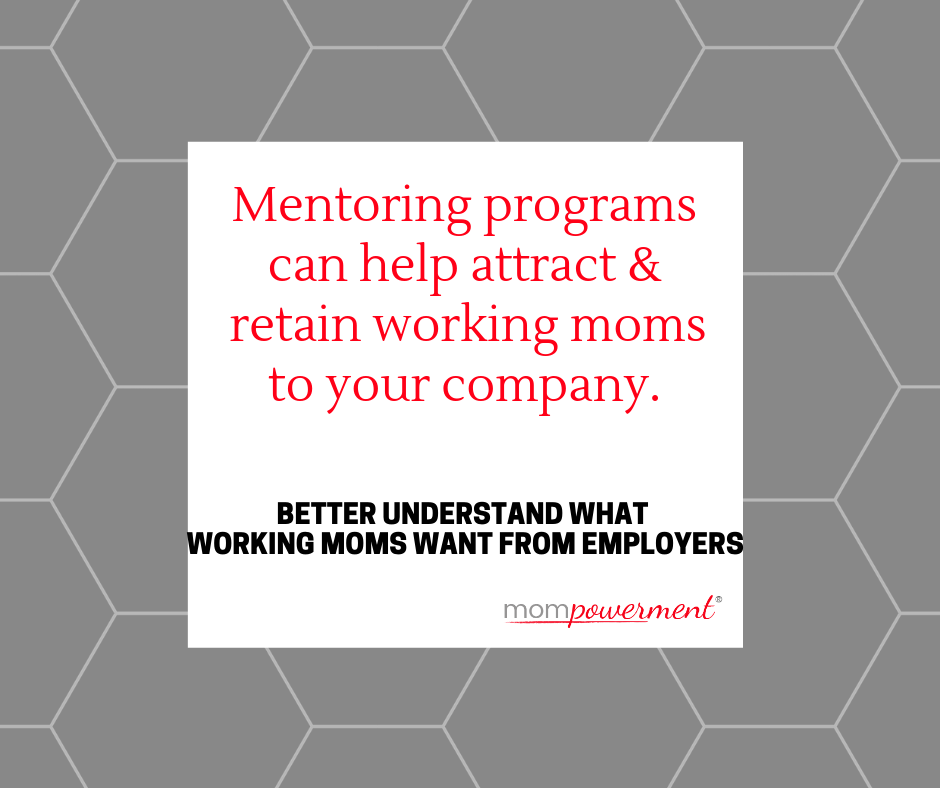
I have written several times about mentors for working moms; I even dedicate part of an entire chapter in both the Mompowerment books. It’s important for working moms to have mentors as part of their tribe. It’s not only about working hard that keeps working moms moving up in the ranks. They need people in their corner giving advice on
How do mentorship programs help employees and employers?
This post is about the company-side of things as it relates to developing mentorship programs. If you’re looking to attract and retain your female employees it’s helpful to consider their long-term trajectory and needs. For those employees who eventually become working moms, their needs changes over time. They go from single to married to mother (and sometimes are sandwiched with also caring for aging family members).
To help working moms in their many roles, as a company you can create employee resource groups, provide flexibility, and pay for or develop tools/resources to help at work and at home. Another area that is helpful and important is enabling more senior women/women leaders to mentor women who are not as far along in their careers or working motherhood journeys.
Ultimately, you’re providing the infrastructure via mentorship programs to help senior women employees share their seasoned advice with those women and working mothers moving up the ladder. You’re creating the space and support to connect these two groups, which might not usually interact or have the change to naturally share ideas. (This can also work in organizations that support entrepreneurs at varying levels of experience.)
As you start to create a new mentorship program, you want to cover some basics upfront:
Benefit of mentorship program
Before we start talking about the benefit to employees, you as a manager, company leader, or HR professional might be wondering why it’s worth it for companies to create a mentorship program. The company will get something out the mentorship program. At its core mentorship can provide a great acquisition and retention tool as well as provide new opportunities for creating relationships and learning opportunities.
When it comes to why employees should care about mentorship opportunities, there are a variety of reasons for creating a mentorship program. Mentorship programs enable participants to transfer knowledge, learn new skills, develop new areas of expertise, help staff develop soft skills, or even create connections between departments. It’s also a simple way to show more junior staff how the world looks as you move up the company ladder. They can see how more senior staff members make professional changes and/or balance all the things. You must be able to articulate this why among the team members who create the mentorship program. And then you need to translate that to the benefits for staff.
Your why will impact all the other aspects of a mentorship program, so consider this first. Once you dig a bit deeper and think through this part, then you can start developing the mentorship program itself.
Decide who can participate
The team that creates the mentorship program needs to decide (and eventually articulate) who can participate. Decide upfront who will participate as the proteges and mentors because you need to create a strategy and communication plan for each party involved. And, really, knowing who you’re targeting will impact all the other areas as you create the mentorship program.
Will proteges be new employees? New managers? Women? New Parents? Will the mentors be mid-level managers? Senior leaders? Women leaders? You also might start with one group to get the kinks out and then expand to other groups.
Where will it take place?
Consider where these engagements will happen? Will this all happen in a lone office if you have more than one (or maybe start in a lone office as a beta test)? If you have multiple offices, can you match people across offices?
Do you want these to be in-person conversations or can they happen through an online tool like Zoom or Skype, especially if your employees travel? What tools can you give participants to facilitate engagement online if it’s across offices?
If these are local interactions, consider the financial aspect. Do mentors submit their expenses if they take their protégés to lunch? You want that to be established early on since it could be a line item in your budget that you must carve out.
Program resources
As you design this program, consider what you ultimately want in your mentorship program. What tools will you provide on getting the most out of the relationship? What coaching will you give to both mentors and proteges? There is all sorts of information on how to find and maintain strong relationships between mentors and proteges. Check out my post. However you want to help get these conversations going, make sure you make the effort to enable and empower employees to find and nurture the relationship with mentors. Announcing a program without providing some sort of coaching or tools to understand best practices likely won’t lead to the results you’re hoping for.
Will you purchase a platform to enable this program? Is it one person’s or team’s responsibility to match people? Think about the tools and people you need to engage to make the program work. Think about what you might need to create to empower both proteges and mentors to be successful in their relationships.
What tools will you provide? For example, create a guide on finding mentors with sample questions and templates (e.g., email communications, ideas on informal versus formal agendas, etc.).
How will you measure success?
A final step that is incredibly important is how you measure the program. If you’re setting aside resources for your teams, you want to make sure that it’s worth it. Set goals and consider how you’ll measure those goals. Make sure that you as a team agree on what success will look like.

A few more tips to help
A few things can help you create the right programs for your needs beyond what has already been shared:
- Get upfront input from different levels. You don’t want to design a new mentorship program in a bubble. Get input from junior, mid-level, and senior staff. Ask recent managers what would have helped them early on. See what senior staff struggles with. Keep that all in mind as you develop your new program.
- Someone must be in charge. Ultimately, someone must be the decision-maker. You can have a team come up with the structure, ideas, etc., but someone has to lead that team. Be very thoughtful about who’s in charge.
- Keep an open-door policy before, during, and after launch. Have a way to collect feedback. Be open to changes while you’re in the process. If you’re open to the feedback, you’ll get it – both positive and negative. If you don’t look for the feedback, you might not be setting yourself up for success.
- Be flexible. Some things that you create initially will be spot-on. Some things simply won’t. Make the necessary changes and evolve the program. Don’t stick with what you have because it’s already done. Change what’s necessary to get the best mentorship program for your needs. And that might require evolving things over time. Look at what could potentially trigger new needs (e.g., acquisition of a new company, influx of new type of employees because of a new project, etc.)
- Do a more formal assessment at specific increments. Decide when you’ll officially ask for feedback. Is that timeframe every 6 months? Is it once a year? Every 2 years? Whatever it is, put a more formal 360-degree assessment in place. Perhaps mentors are really happy, but proteges aren’t getting what they need. Maybe both proteges and mentors are thrilled, but the team that runs it is running ragged and needs additional staff. Look at the full view of the program before making adjustments.
If you’ve already created a mentorship program, what has helped you ensure its success? What tips would you share? If you’re trying to create a program, what hurdles are in your way?
If you’d like Mompowerment to help you create resources like mentorship programs, email me directly. Whether brainstorming with your internal team, helping you create the right programs for your employees’ needs, providing in-person or online workshops, or buying books in bulk (special pricing for purchases of 20+ books), Mompowerment is here to help. We can get those resources in place quickly and give your teams practical tips and tools to start creating more balance in their lives.


